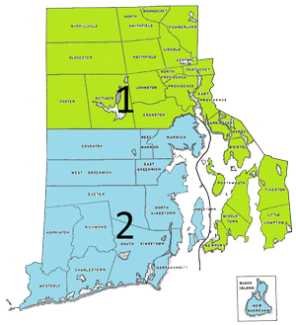Wildfire Danger Report
In some cases fire is good for a forest, but unplanned fires that burn too hot can make it hard for the forest to recover. Wildfires are unplanned and unwanted fires that are very dangerous to people who use the forests and outdoor areas or live in nearby homes and communities. Wildfires can also cause a lot of damage to some plants and animals and their homes.
Fire Weather Status

Fire District Map
District 1: Providence, Bristol & Newport Counties
District 2: Kent & Washington Counties
What you need to know: red flag warnings and fire restrictions
Definitions of a Fire Weather Watch and a Red Flag Warning
A Fire Weather Watch or Red Flag Warning is issued when the combination of dry fuels and weather conditions support extreme fire danger. These alerts are written for land and fire managers to highlight the increased fire danger.
A Fire Weather Watch is issued up to 72 hours before the above conditions are expected to occur.
A Red Flag Warning is issued when the conditions above are expected to occur or are occurring within the next 24 hours.
Red Flag Warnings
Red Flag Warnings are usually only issued during the spring and fall fire weather seasons, February 15 – April 30 and October 1 - December 15. A red flag warning is issued when warm temperatures, very low humidity, and stronger winds are expected to combine to produce an increased risk of fire danger that will occur within 24 hours and could exist in the next 12-72 hours. A Red Flag Warning is the highest fire alert. The National Weather Service issues a Red Flag Warning when the following is expected:
- Warm Temperatures: Ten-hour fuels of 8% or less. This parameter describes how much water is held by small vegetation such as grass, leaves, and mulch that take only about ten hours to respond to changes in dry/wet conditions.
- Very Low Humidity: Relative humidity (RH) less than 25% for several hours. RH depicts how much water is in the air, relative to the temperature of the air.
- Stronger Winds: Winds 20 feet off the ground of at least 15 mph for several hours.
Remember Smokey’s Five Rules of Wildfire Prevention:
- Only you can prevent wildfires
- Always be careful with fire
- Never play with matches or lighters
- Always watch your campfire
- Make sure your campfire is completely out before leaving it
If you spot a forest fire: remain calm, go to the nearest telephone, and dial 911 to report the fire as quickly as possible to your local fire department. Calmly tell the emergency dispatcher when you saw it and where you saw it. If you see anything suspicious at or near the scene of the fire, take note and relay that to 911 as well. Stay on the telephone until the dispatcher tells you to hang up.
Know Before You Go: Elevated Fire Weather May Impact Use of Campfires at State Campgrounds, Parks, and Management Areas
The campfire is a big part of the camping experience for many who love camping and the outdoors. However, please be aware that public lands managed by DEM including RI State Campgrounds may not allow open campfires when the National Weather Service issues a RED FLAG WARNING.
Contact the campground to learn about any active open fire restrictions. While we hope to welcome you to state campgrounds soon, if you prefer to cancel or reschedule your reservation, please log on to the Reserve America website or call 1-877-742-2675. Please note that regular cancellation and reservation change policies will apply.
While a Red Flag Warning is active, the following activities may not be allowed:
Prohibited Activities
- No Campfires
- No Charcoal fires
- No Cooking fires
- No Candles
- No devices that emit flames or embers
Allowed Activities
- Portable cooking stoves using liquefied or bottled fuels
- Propane/liquid-fueled lanterns
- Propane fire pits
Additional Resources
- State Land Stewardship
- National Weather Service
- Rhode Island Emergency Management Agency
- Preventing Wildfire Resources from Smokey Bear
Air Quality Status
- View DEM's latest Air Quality Forecast
- Download the AirNow Mobile App to view the Fire and Smoke Map.
- Subscribe to EnviroFlash to receive air quality alerts directly to your inbox!
